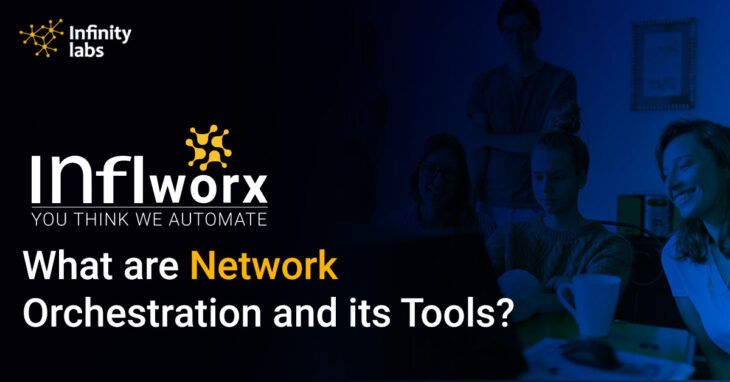
A customer request for virtual servers can be sent to Network Orchestration using a web interface. This program will assess the network setup, alter it for the customer, and update the billing system. A tunnel across the WAN is one solution. The synchronized service setup across multiple devices and platforms is crucial for establishing connectivity.
A vendor-neutral format for network configuration, operational data, and policy are captured using Network Orchestration. Network architects customize built-in service models, and Orchestrator handles infrastructure variations. By eliminating the complexity of managing vendor-specific CLIs, network services may be deployed in minutes instead of hours. Assume the operator must construct a VLAN for a particular application. The operator must log in to each router and configure it through CLI or GUI. However, a Network Orchestrator automatically detects the network topology and dependencies for constructing VLANs. In addition, it initiates an atomic transaction across all vendor devices in the identified path.
Why is Network Orchestration Vital?
Increasingly complex devices and services necessitate orchestration as we transition to a contemporary network since manual interaction is no longer possible. By abstracting this complexity into templates or models, orchestration enables a network engineer to have easy visibility into this complexity. YANG, TOSCA, Heat Orchestration Templates, and YAML are some of the most often used modeling or templating languages. This view allows centralized administration of operations to maintain network efficiency, consistency, and quality.
It is not necessary to manage your network in a software-defined environment. Virtualizing functions through network function virtualization without orchestration is still possible. You may manually spin up and down these virtual machines to perform their functions.
Even if you don’t require network orchestration, don’t ignore it! Many convincing arguments exist to support this path. Orchestration is crucial if your main goal is to automate and digitize. It makes deploying the essential functionality easier and faster. You will also be able to quickly repair issues without taking critical systems offline for days or hours and quickly launch new products to consumers.
Business Benefits of Network Orchestration
Technology and vendor lock-in is avoided using Network Orchestration. It has no hard-coded parameters for introducing new device kinds and services. It offers seamless integration and automation with customers’ self-service portals, third-party web apps, and OSS/BSS through REST APIs.
A low-risk technique allows customers to see rapid returns. It can initially run with or replace current EMS/NMS solutions. Six months is the typical payback time for Network Orchestration.
One of the benefits is increasing income by reducing time-to-market for new services using Network Orchestration. Time-to-market is decreased from months to hours by quickly building and launching new services. New device types are added to the system through adjustable MIB polling policies and rules every few minutes. Automated services are supplied through GUI or REST API to optimize network agility and programmability.
Network Orchestration cuts OpEx. A comprehensive REST API unifies traditional network administration with open, SDN-style network programmability and Service Lifecycle Orchestration, reducing costs by up to 80% and doubling up on value.
With Network Orchestration, you can manage end-to-end, multi-vendor networks from a single pane of glass, eliminating operational silos and reducing complexity.
Challenges of network orchestration
- Using numerous distributed systems natively typically leads to inefficient resource usage because we construct silos, i.e., portions of CPU, memory, storage, and network resources allocated to each service.
- It’s already difficult to manage so many services, but what if you add several tenants with their requirements and all segregated with security controls?
Network Orchestration Tools
Here are a few Network Orchestration Tools:
SolarWinds Network Automation Manager
A leader in network management and monitoring software, Solarwinds Network Automation Manager, is an on-premises, cloud, and hybrid network management solution.
Solarwinds NAM enables:
- Network monitoring
- Analyze traffic and
- Change management
- Switch port and end-user tracking
- WAN monitoring
- IP address control
Solarwinds offers a 30-day Free Trial. Network Performance Monitor, NetFlow Traffic Analyzer, Network Configuration Manager, IP Address Manager, User Device Tracker, VoIP & Network Quality Manager, etc. Packages include Network Bandwidth Analyzer Pack, Log and Network Performance Pack, and IP Control Bundle. Find out more about Solarwinds Network Management.
Ansible
Ansible is an automation system that functions as a resource provisioner, configuration management tool, and application release automation and can provision and manage the whole application and infrastructure environments.
Ansible “Playbooks” allow users to represent their surroundings in a human-readable format. Instead of controlling one system at a time, playbooks provide a holistic picture of how the infrastructure’s many systems interact. Finally, Ansible does not need extra bespoke security architecture since it is agentless.
TrueSight Network Automation
Security vulnerabilities, configuration, compliance, and provisioning can be automated using TrueSight Automation for Networks.
Vulnerability monitoring, provisioning, setup, auditing, and maintenance of network equipment like routers and switches may be automated and accelerated with TrueSight Automation for Networks.
VMware NSX
All networking and security functions are virtualized in VMware NSX. Accelerates installations, improves security, and reduces time and money by eliminating manual, error-prone operations combined with vRealize Automation and VMware Cloud Foundation.
VMware’s Network Automation Products include:
- Connecting and securing applications across data centers, clouds, bare metal, and containers. A full L2-L7 networking and security virtualization platform
- It provides self-service automation, DevOps for infrastructure, configuration management, and network automation features.
- It enables secure infrastructure and operations across private and public clouds. A hybrid cloud gives the corporate agility and flexibility.
Conclusion
Inevitably, networks will change. One of the best things about free and open-source software like Ansible and Netmiko is how much freedom they provide. Using these automation tools might be difficult for network administrators since they need high coding expertise. You can only request a demo of some of these products if they don’t have a free trial available. The other option is to provide a free trial. To learn more, reach out to the experts at Infinity Labs.